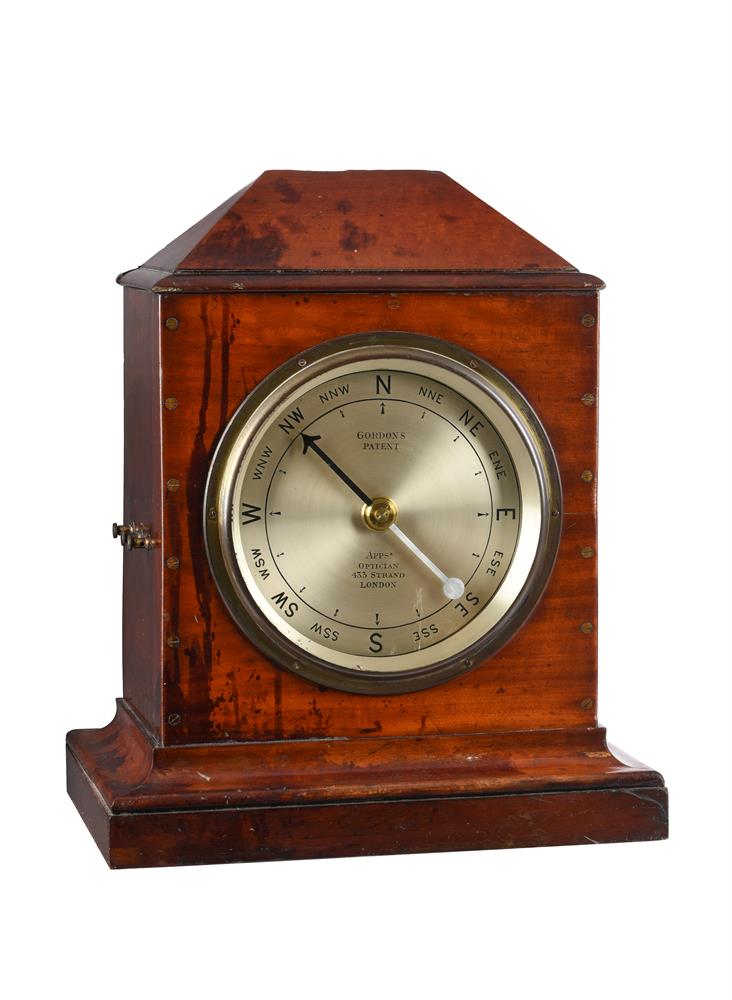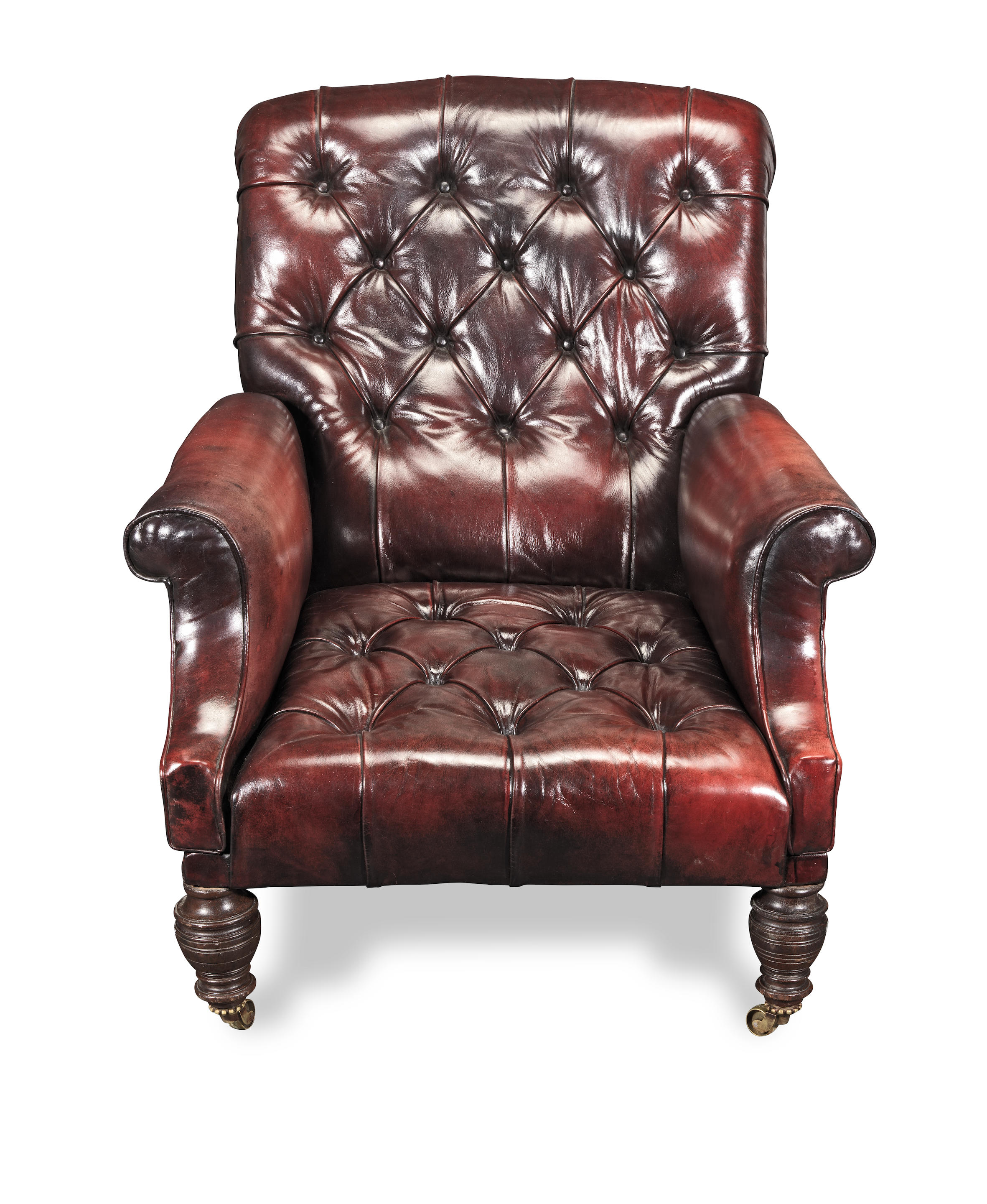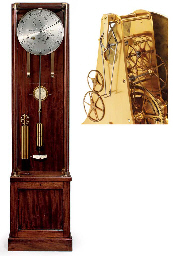A rare Victorian mahogany mercury cistern tube marine stick barometer with sympiesometer D. Mc.Gregor and Company Limited, Glasgow, Greenock and Liverpool, late 19th century With cavetto moulded caddy pediment above rectangular glazed doudle canted ivorine scales flanking tube each calibrated for barometric inches together with the usual observations beneath annotations 10 a.m. YESTERDAY and 10 a.m. TO-DAY and signed D. Mc.GREGOR & Co. LTD, GREENOCK, GLASGOW, & LIVERPOOL to upper margin, the trunk with cavetto shaped sides flanking twin vernier adjustment screws to throat over brass gimbal mount with hinged post for wall mounting and rectangular section trunk applied with glazed sympiesometer configured with silvered scale applied with siphon tube with open bulb to the left and sealed bulb to the right filled with green stained fluid, the left hand margin with mercury tube Fahrenheit scale thermometer opposing right hand side with engraved vertical scale for degrees Fahrenheit ranging between 30 and 140 set behind slide with expanded scale annotated for barometric inches and with the usual weather observations, the upper edge of the slide fitted with angled pointer for calibration against the temperature scale behind and with sliding adjustment to a knurled brass knob fitted to the right hand side of the case, the upper left hand corner with recessed circular level recording disc labelled REGISTER and engraved with barometric scale visible through an arched aperture in the plate and manually adjusted via projecting rim to the exterior of the case, the lower margin inscribed IMPROVED SYMPIESOMETER, the barometer trunk continuing beneath terminating with a moulded brass cylindrical cistern, 93cm (36.5ins) high. D. McGregor and Company Limited are recorded in Banfield, Edwin BAROMETER MAKERS AND RETAILERS 1660-1900 as working from Clyde Place, Glasgow, Greenock and Liverpool from 1856 until after 1900. The sympiesometer was invented by Alexander Adie of Edinburgh in 1818 and is essentially an improved version of Robert Hooke's thermobarometer which was subject of a paper presented to the Royal Society in 1668. The instrument works by having a siphon tube filled with liquid open to the air at one end and with trapped gas at the other (sulphuric acid and hydrogen were used in later sympiesometers). As barometric pressure increases the liquid will be forced down the tube causing the gas to be compressed, resulting in a change in level in the tube. Unfortunately the volume of the gas changes with temperature so before a reliable reading can be taken the instrument would first need to be calibrated by adjusting the position of the movable barometer scale in relation to the temperature scale behind to reflect the reading provided by the thermometer. The sympiesometer was intended as a replacement for the marine barometer due to its compact portable proportions and lesser susceptibility to the pitch and yaw of a ship however the taking of readings can take a little longer than for a traditional barometer due to the need to 'calibrate' the scale for temperature. The current lot is unusual in that it combines both a barometer and sympiesometer in the same instrument thus has the advantages of both as well as allowing the accuracy of each to be cross-referenced. Condition report disclaimer
A rare Victorian mahogany mercury cistern tube marine stick barometer with sympiesometer D. Mc.Gregor and Company Limited, Glasgow, Greenock and Liverpool, late 19th century With cavetto moulded caddy pediment above rectangular glazed doudle canted ivorine scales flanking tube each calibrated for barometric inches together with the usual observations beneath annotations 10 a.m. YESTERDAY and 10 a.m. TO-DAY and signed D. Mc.GREGOR & Co. LTD, GREENOCK, GLASGOW, & LIVERPOOL to upper margin, the trunk with cavetto shaped sides flanking twin vernier adjustment screws to throat over brass gimbal mount with hinged post for wall mounting and rectangular section trunk applied with glazed sympiesometer configured with silvered scale applied with siphon tube with open bulb to the left and sealed bulb to the right filled with green stained fluid, the left hand margin with mercury tube Fahrenheit scale thermometer opposing right hand side with engraved vertical scale for degrees Fahrenheit ranging between 30 and 140 set behind slide with expanded scale annotated for barometric inches and with the usual weather observations, the upper edge of the slide fitted with angled pointer for calibration against the temperature scale behind and with sliding adjustment to a knurled brass knob fitted to the right hand side of the case, the upper left hand corner with recessed circular level recording disc labelled REGISTER and engraved with barometric scale visible through an arched aperture in the plate and manually adjusted via projecting rim to the exterior of the case, the lower margin inscribed IMPROVED SYMPIESOMETER, the barometer trunk continuing beneath terminating with a moulded brass cylindrical cistern, 93cm (36.5ins) high. D. McGregor and Company Limited are recorded in Banfield, Edwin BAROMETER MAKERS AND RETAILERS 1660-1900 as working from Clyde Place, Glasgow, Greenock and Liverpool from 1856 until after 1900. The sympiesometer was invented by Alexander Adie of Edinburgh in 1818 and is essentially an improved version of Robert Hooke's thermobarometer which was subject of a paper presented to the Royal Society in 1668. The instrument works by having a siphon tube filled with liquid open to the air at one end and with trapped gas at the other (sulphuric acid and hydrogen were used in later sympiesometers). As barometric pressure increases the liquid will be forced down the tube causing the gas to be compressed, resulting in a change in level in the tube. Unfortunately the volume of the gas changes with temperature so before a reliable reading can be taken the instrument would first need to be calibrated by adjusting the position of the movable barometer scale in relation to the temperature scale behind to reflect the reading provided by the thermometer. The sympiesometer was intended as a replacement for the marine barometer due to its compact portable proportions and lesser susceptibility to the pitch and yaw of a ship however the taking of readings can take a little longer than for a traditional barometer due to the need to 'calibrate' the scale for temperature. The current lot is unusual in that it combines both a barometer and sympiesometer in the same instrument thus has the advantages of both as well as allowing the accuracy of each to be cross-referenced. Condition report disclaimer















Testen Sie LotSearch und seine Premium-Features 7 Tage - ohne Kosten!
Lassen Sie sich automatisch über neue Objekte in kommenden Auktionen benachrichtigen.
Suchauftrag anlegen